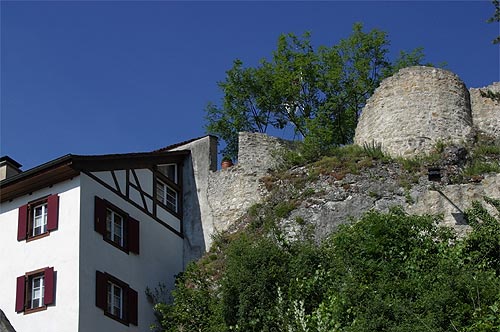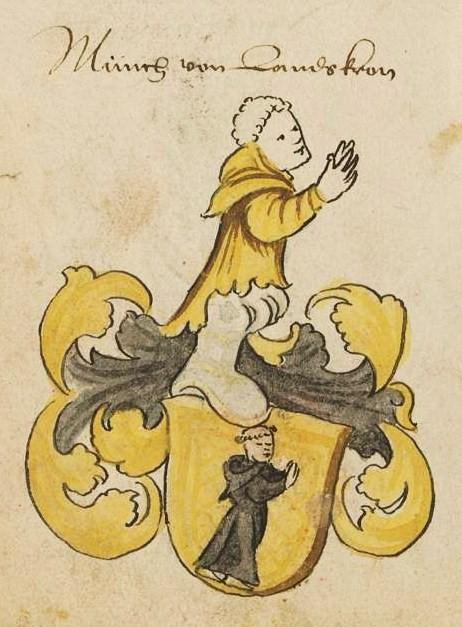|
Trotte (Münchenstein)
The Trotte (formerly known as the Zehntentrotte) lies in the village centre of Münchenstein, in the Cantons of Switzerland, canton of Basel-Country in Switzerland. The German word ''Trotte'' means ''wine press''. Location The ruins of Münchenstein Castle are situated on a long, but narrow rock above the urban centre of Münchenstein. The oldest residential buildings, that form the village centre are strung in a row along the foot of the castle rock. This pattern is interrupted by the inclination of the Trotte, which is situated directly below the castle ruins. History Up until the foundation and the erection of the Castle (Schloss), the small residential colony had only a few houses and the village was named Geckingen. The first historical records in written form was in 1196 and the colony was named as Kekingen. Around the year 1260 the up-rising cavalier family Münch (family lineage), Münch acquired the village on the hills adjacent to the river Birs and established their e ... [...More Info...] [...Related Items...] OR: [Wikipedia] [Google] [Baidu] |
Münchenstein
Münchenstein (Swiss German: ''Minggestai'') is a municipality in the district of Arlesheim in the canton of Basel-Landschaft in Switzerland. Historical records Münchenstein is first mentioned in 1196 as ''Kekingen''. In 1270, it was mentioned as ''Geckingen'' and in 1279 as ''Munchenstein''. * 1259: The hamlet and the mill, between "Neue Welt" and St. Jakob, are mentioned in a deed as being owned by the Basel Dompropstei (Provost's Church). * 1270: The village is named in the Bishop of Basel diocese certificate as Geckingen. * 1295: The mention of the name in the current form "Munchenstein", which means the "rock of the castle of the Münchs". The first part of the name refers to the builders of the castle, and the second part means stone and refers to the foundations of the castle. * 1324: The Münchs were not able keep the village and castle for long as their own Property, they had to hand over ownership to the Graf von Pfirt, who then lent it to the Münchs in fief. Fol ... [...More Info...] [...Related Items...] OR: [Wikipedia] [Google] [Baidu] |
Cantons Of Switzerland
The 26 cantons of Switzerland (german: Kanton; french: canton ; it, cantone; Sursilvan and Surmiran: ; Vallader and Puter: ; Sutsilvan: ; Rumantsch Grischun: ) are the member states of the Swiss Confederation. The nucleus of the Swiss Confederacy in the form of the first three confederate allies used to be referred to as the . Two important periods in the development of the Old Swiss Confederacy are summarized by the terms ('Eight Cantons'; from 1353–1481) and ('Thirteen Cantons', from 1513–1798).rendered "the 'confederacy of eight'" and "the 'Thirteen-Canton Confederation'", respectively, in: Each canton of the Old Swiss Confederacy, formerly also ('lieu/locality', from before 1450), or ('estate', from ), was a fully sovereign state with its own border controls, army, and currency from at least the Treaty of Westphalia (1648) until the establishment of the Swiss federal state in 1848, with a brief period of centralised government during the Helvetic Republic ( ... [...More Info...] [...Related Items...] OR: [Wikipedia] [Google] [Baidu] |
Basel-Country
Basel-Landschaft or Basel-Country informally known as Baselland or Baselbiet (; german: Kanton Basel-Landschaft ; rm, Chantun Basilea-Champagna; french: Canton de Bâle-Campagne; it, Canton Basilea Campagna), is one of the 26 cantons forming the Swiss Confederation. It is composed of five districts and its capital city is Liestal. It is traditionally considered a " half-canton", the other half being Basel-Stadt, its urban counterpart. Basel-Landschaft is one of the northernmost cantons of Switzerland. It lies essentially south of the Rhine and north of the Jura Mountains. The canton shares borders with the canton of Basel-Stadt to the north, the canton of Aargau to the east, the canton of Solothurn to the south and the canton of Jura to the west. It shares international borders as well with France and Germany to the north. Together with Basel-Stadt, Basel-Landschaft was part of the canton of Basel, who joined the Old Swiss Confederacy in 1501. Political quarrels and armed c ... [...More Info...] [...Related Items...] OR: [Wikipedia] [Google] [Baidu] |
Switzerland
). Swiss law does not designate a ''capital'' as such, but the federal parliament and government are installed in Bern, while other federal institutions, such as the federal courts, are in other cities (Bellinzona, Lausanne, Luzern, Neuchâtel, St. Gallen a.o.). , coordinates = , largest_city = Zürich , official_languages = , englishmotto = "One for all, all for one" , religion_year = 2020 , religion_ref = , religion = , demonym = , german: Schweizer/Schweizerin, french: Suisse/Suissesse, it, svizzero/svizzera or , rm, Svizzer/Svizra , government_type = Federalism, Federal assembly-independent Directorial system, directorial republic with elements of a direct democracy , leader_title1 = Federal Council (Switzerland), Federal Council , leader_name1 = , leader_title2 = , leader_name2 = Walter Thurnherr , legislature = Fe ... [...More Info...] [...Related Items...] OR: [Wikipedia] [Google] [Baidu] |
Wine Press
A winepress is a device used to extract juice from crushed grapes during wine making. There are a number of different styles of presses that are used by wine makers but their overall functionality is the same. Each style of press exerts controlled pressure in order to free the juice from the fruit (most often grapes). The pressure must be controlled, especially with grapes, in order to avoid crushing the seeds and releasing a great deal of undesirable tannins into the wine. Wine was being made at least as long ago as 4000 BC; in 2011, a winepress was unearthed in Armenia with red wine dated 6,000 years old. Press types Basket A basket press consists of a large basket filled with the crushed grapes. Pressure is applied through a plate that is forced down onto the fruit. The mechanism to lower the plate is often either a screw or a hydraulic device. The juice flows through openings in the basket. The basket style press was the first type of mechanized press to be developed, and i ... [...More Info...] [...Related Items...] OR: [Wikipedia] [Google] [Baidu] |
Münchenstein Castle
Münchenstein Castle (german: Ruine Münchenstein) is a landmark above the village centre of Münchenstein, in the canton of Basel-Land in Switzerland. The ruins of the castle (Schloss) can still be visited and viewed, but are under private ownership. Location The ruins of Münchenstein Castle are situated on a long, but narrow rock. There are only slender remains of the walls to be seen, these are directly above the centre of the village. The ruins of the castle (Schloss) can still be visited and viewed, but are under private ownership. History Up until the foundation and the erection of the Castle (Schloss), the small residential colony only had a few houses and was named Geckingen. The first historical records in written form was in 1196 and the colony was named as Kekingen. [...More Info...] [...Related Items...] OR: [Wikipedia] [Google] [Baidu] |
Münch (family Lineage)
The Münch were a Swiss knightly family in the city of Basle and its environs. The first mention of the family dates from 1154; it died out in 1759. In the thirteenth century it was, with the Schaler family, one the most influential families in Basle. ''(in German)'' From about the end of the fourteenth century members of the family took no further part in the political life of the city. History The earliest mention of the family dates from 1154, when a Münch was in the service of the List of bishops of Basel, Prince-Bishop of Basel. During the thirteenth century members of the family built a number of castles in the country surrounding Basle, and these gave rise to a variety of branches of the family. Some of these were soon extinguished – the Münch of Stettenbe ...[...More Info...] [...Related Items...] OR: [Wikipedia] [Google] [Baidu] |
Birs
The Birs (French: ''Birse'') is a long river in Switzerland that flows through the Jura region and ends as a tributary to the Rhine between Basel and Birsfelden. It is the most important river of the Swiss Jura. Course The Birs has its source in a spring near the ''Col de Pierre Pertuis'' at above sea level a little southwest of Tavannes in the ''Jura bernois''. It starts as a proper river; the large amount of water is the product of an extended underground river system. The Birs runs through wider valleys (Vallée de Tavannes) and narrow gorges. Near Delémont, the capital of the canton of Jura, it joins the Sorne and the Scheulte. Between Soyhières and Liesberg, it leaves the French-speaking part of Switzerland, enters the canton of Basel-Landschaft and receives the Lützel from the left. In Laufen it forms a waterfall, which was the source of power and of the name of the city. At the gorge of Angenstein, the river runs into the ''Birseck'', the lowland by Aesch. Bet ... [...More Info...] [...Related Items...] OR: [Wikipedia] [Google] [Baidu] |
Basel
, french: link=no, Bâlois(e), it, Basilese , neighboring_municipalities= Allschwil (BL), Hégenheim (FR-68), Binningen (BL), Birsfelden (BL), Bottmingen (BL), Huningue (FR-68), Münchenstein (BL), Muttenz (BL), Reinach (BL), Riehen (BS), Saint-Louis (FR-68), Weil am Rhein (DE-BW) , twintowns = Shanghai, Miami Beach , website = www.bs.ch Basel ( , ), also known as Basle ( ),french: Bâle ; it, Basilea ; rm, label= Sutsilvan, Basileia; other rm, Basilea . is a city in northwestern Switzerland on the river Rhine. Basel is Switzerland's third-most-populous city (after Zürich and Geneva) with about 175,000 inhabitants. The official language of Basel is (the Swiss variety of Standard) German, but the main spoken language is the local Basel German dialect. Basel is commonly considered to be the cultural capital of Switzerland and the city is famous for its many museums, including the Kunstmuseum, which is the first collection of art accessibl ... [...More Info...] [...Related Items...] OR: [Wikipedia] [Google] [Baidu] |
1356 Basel Earthquake
The 1356 Basel earthquake is the most significant seismological event to have occurred in Central Europe in recorded history and had a moment magnitude in the range of 6.0–7.1.Centrale Nucléaire de Fessenheim : appréciation du risque sismique RÉSONANCE Ingénieurs-Conseils SA, published 2007-09-05, pages 12, 13 This earthquake, which occurred on 18 October 1356, is also known as the Sankt-Lukas-Tag Erdbeben (English: Earthquake of Saint Luke), as 18 October is the feast day of Saint . Earthquake |
Burkhard VII , Swiss compression technology enterprise
{{disambiguation, geo ...
Burchard (and all variant spellings) may refer to: __NOTOC__ People * Burchard (name), Burchard and all related spellings as a given name and surname * Burckhardt, or (de) Bourcard, a family of the Basel patriciate * Burchard-Bélaváry family, an aristocratic family of Hungarian origin, originally called ''Both de Szikava et Bélavár'' Places in the United States * Burchard, Minnesota * Burchard, Nebraska * Burkhardt, Wisconsin Other uses * Burckhardt (crater), a lunar impact crater * Burkhardt (grape) (also Burkhardt's Prince), a French red wine grape better known as Aramon * Burckhardt Compression Burckhardt Compression AG is a Winterthur-based Swiss firm specialising in reciprocating compressors. According to the enterprise, it is the world leader in this field, with its products being used around the world in various industrial applicati ... [...More Info...] [...Related Items...] OR: [Wikipedia] [Google] [Baidu] |






